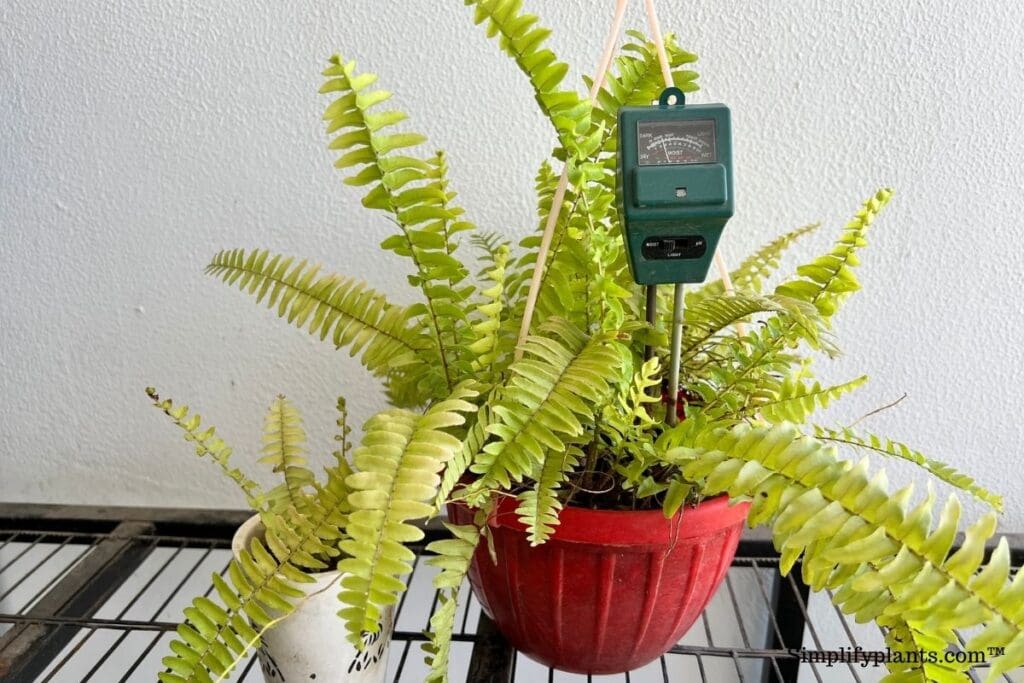How To Bring Boston Fern Inside For Winter?
Boston ferns are popular plants chosen for decorating outdoor spaces like patios, balconies, or shady windows because these plants thrive in the shade. But one question that can bother Boston fern owners is if these need to be brought inside during winter and how.
Boston ferns are tropical houseplants that can’t tolerate harsh winters, so you must overwinter them by bringing them inside.
To bring your Boston fern inside for winter, start by giving the plant a good prune and gradually move it indoors. Once you get them in, stop fertilizing the plant, water sparingly, and maintain temperatures above 55°F. Also, make sure to keep your Boston fern under bright indirect light.
In this article, I will explain how you can overwinter your Boston fern and bring it inside during winter. I will also share some winter care tips to help your Boston fern survive the season.

Please note: Simplify Plants is reader-supported. Some links in the post are affiliate links and I get a commission from purchases made through links in the post.
What is the lowest temperature Boston fern can handle?
Boston ferns are native to tropical warmer areas like Mexico, Florida, and central and south America and cannot tolerate harsh cold.
They are different from other ferns that are well equipped to handle temperatures as low as 45°F, which is not the case for Boston ferns.
If the temperature goes as low as 40°F in your area, you will have to winterize by bringing the Boston fern indoors, protecting it in a warm, comfortable setup, and mulching it to prevent moisture loss.
Boston ferns ideally thrive in a temperature range of 60-75°F.
However, it can still tolerate temperatures as low as 50°F, but you have to pay special attention to the plant and overwinter it if the temperature goes below that.
Also read: Boston Fern Temperature Tolerance: +Ideal Temperature
Can Boston ferns stay outdoors in winters?

An important thing you need to understand is the hardiness zones the fern grows in.
Boston fern owners in USDA Hardiness Zones 8b through 11 with milder winters can let their Boston ferns enjoy outside all year round with proper winter care, but that is not so under zone 7A.
Boston ferns are intolerant to frost, and if you leave your fern outside in such weather, you cannot reverse the damage.
If you live in a warmer hardiness zone like 10 or higher, you can leave the Boston fern outside during winters because the winters are not that harsh in these regions.
Anywhere where the winter temperatures dip below 50°F is not suitable to grow the Boston ferns outside in winters.
How to overwinter your Boston ferns?
You need to understand a few things to keep the Boston fern through the cold.
You must begin the overwintering process before the first frost occurs because once your Boston fern gets hit by a hard frost, saving the plant can get difficult.
Late autumn to early winter is a good time to start the overwintering process.
Shifting your Boston ferns indoors to protect them from winters is the most popular and easiest way to overwinter a Boston fern.
You can shift it to your living room, kitchen, or garage, where there is light and warmth when you notice the first signs of dormancy.
In this season, they begin slowing the growth rate, and the green fronds turn brown and yellow and eventually begin to shed many leaves.
This is normal, and you need to begin the process immediately without further delay.
Winterizing these gorgeous beauties involves a few primary steps: knowing the right time to start pruning, pruning, and moving them indoors to a sheltered spot.
Let us understand these steps in greater detail so that you know your course of action.
Cut back

Pruning your Boston fern is the first step in starting the process of overwintering.
However, you have to know the right time to begin this action.
Pruning at the wrong time can send your plant to stress and damage it.
You must prune your Boston fern in the fall right before the cold because your ferns are not adapted to tolerate the cold.
If you live in the areas of USDA Hardiness Zones 10-12, the correct time to prune your Boston fern is around October to November.
Let us quickly understand the right way to prune your Boston fern:
- Get a clean pair of pruning shears to sterilize them, and this will prevent the transfer of any germs or fungus to your healthy ferns.
- Trim down the longest foliage. They are quite easy to cut across.
- Trim off several inches of the large fronds. Do not be scared because they will grow back swiftly once spring arrives. Cutting these fronds prevents the risk of diseases and pests from coming feeding on the leaves in winters.
- After cutting them, clean any leftover clippings that may have fallen on the soil while trimming.
- If your fern is in a container, hold the plant securely and flip it upside down to shake it a little.
- Wash off your Boston fern with a hose to clean off all the dirt and debris accumulated on the fronds. Check thoroughly to find leftover parts because insects come to feed on them and create a risk for your plant. Washing it also removes any pests or bugs that might have gotten them attached to the fern.
- Your Boston fern should have some inches of leaves left.
- Do not disturb these leaves, as they will give the plant a head start in the growing season.
- Now your fern is ready to be brought inside and begin the process of overwintering.
Also read: Should I Trim My Boston Fern? (+How To Prune)
Bringing it inside

Now before bringing the fern inside, make sure it is completely dry.
Allow it to absorb all that water and keep it in some light so that the water can evaporate.
Next, before beginning the entire process, you have to choose the correct location for your Boston fern inside your home.
It is recommended to keep the plant somewhere you can daily see and monitor the plant’s health.
Now we will discuss the primary requirements while choosing the right spot for your Boston fern:
- Should be away from cold drafts, vents, or areas that experience temperature fluctuations
- It should be out of the reach of children or pets that might often disturb the plant.
- Should receive dappled or indirect sunlight. Boston ferns do not require too bright light during winters as that can burn the foliage.
- It should not get rubbed against walls or windowpanes.
- The area must be cool but protected from extremely freezing temperatures. Many choose to overwinter their ferns in garages or a corner of their living rooms.
- The location’s temperature should be around 50-60°F.
Make sure to make the transition gradual.
If you have a Boston fern that’s growing in soil, take it out and plant it in a pot.
Start this process before harsh winter hits the area.
Bring the potted Boston fern indoors for 1-2 hours and increase the time by a few hours after every few days.
Check how your plant reacts to it.
Keep doing this for a few days and then you can shift it inside for the entire winter.
Watering

Your Boston fern does not need a lot of water in the cold months.
However, that does not mean you can leave it bone dry.
Water it when you see the top one or two inches of the soil has become dry.
Do not forget to check the moisture content of the soil before watering them if you are unsure when to water it.
Use a moisture meter for the same.
Also read: How To Water Boston Fern? (How Often, How Much & More)
Fertilizer
Refrain yourself from fertilizing your Boston fern in winters.
Due to the slow growth, the chances of burn get higher when you fertilize them.
Since the plant is more dormant, they do not need fertilizer during this time until spring arrives.
Since Boston ferns are light feeders, they only need feeding in the growing season.
Also read: Should I Fertilize My Boston Fern? (Ideal Fertilizer+When & How Much)
Pruning
Your Boston fern will not look that gorgeous or bushy during this season.
They may be slightly yellow and look wilted.
Do not worry because it happens due to cold and dry air.
Prune off the dead or yellow leaves to avoid bugs feeding on them.
It also helps the plants prevent wasting their energy on keeping these fronds.
Remember, your Boston ferns might not look extremely beautiful at this point.
It will look scraggly and pale.
Your target is to make the plant survive through the winters and not beautify it.
The leaves may look pale and fall off to the ground.
Do not fret.
Once warmer temperatures return, your fern will regain its color, vigor, and strength.
Will your Boston fern grow back after winter?

If the process of overwintering your Boston fern is correct, it will resume growth in early spring and go back to its lush and full self.
Boston ferns are perennial plants designed to regrow every year, provided they get the right growing conditions.
In extremely cold places, the ferns may lose their fronds and the feathery top, but the roots will stay alive, and once the warmer temperatures arrive, it starts to regrow again.
Will my Boston fern come back?
In nature, Boston ferns are perennials, so they are capable of coming back every year.
With the advancement of warmer temperatures, the plant will again resume its growth.
Once the spring arrives, you can take your plant outdoors again if you wish to.
However, you must remember to gradually assimilate the plant with the outdoor environment instead of suddenly shifting it outside.
However, you might lose it if your Boston fern has been exposed to absolutely intolerable conditions.
If you find your Boston fern not coming back, it may be due to any of the following reasons:
- The fern was exposed to harsh cold for a long period. Though they are hardy plants, they can suffer huge damage if exposed to cold for a long time.
- It was not properly cared for during the overwintering process.
- It has undergone plant shock.
- It was exposed to frost, which killed it.
- It got infected with molds or fungus during the winters.
- It suffered underwatering.
- It was not correctly hardened off.
Can hanging ferns survive winters?

Many growers wonder what precautions they should take for their Boston ferns in hanging baskets.
Like the ferns growing in soil or pots, the hanging baskets also need to be brought inside.
Being in the air does not make them immune to the harsh cold air and frost.
You have to follow the same tips for the hanging ferns and bring them indoors in a safe spot for the winters.
Care tips for Boston ferns in winters
- Do not keep the Boston fern exposed to harsh outdoor cold for a long time.
- Bring it indoors before the frost can hit your fern.
- Check the soil before watering your fern in winter. It needs very little water during its dormant phase, so water once a week or for 15 days, depending on the cold and soil needs.
- Be very careful about checking the plant daily for any signs of pests or bugs.
- Before bringing the Boston fern inside, wash the fronds well and clear off any pests or bugs looming underneath the fronds.
- Never fertilize the fern during this period. You might feel like the fern needs food due to its skinny fronds but refrain from feeding it at every cost.
- The fern may shed many leaves during this time, creating a mess inside your home. This is a part of its dormant stage. But, you can trim off the dead leaves to avoid the mess.
- Overwinter the Boston fern gradually. Start before the harsh winter hits by bringing the plant inside for a few hours and increasing it gradually. Bringing the plant inside all of a sudden will shock it.
- Once winter gets over, you can again take your fern outside by gradually exposing it to the outdoor light and air.
Final thoughts
After going through this article, you must have heard everything about the correct way to bring your Boston fern indoors for winters so that they can survive it without you having to worry about buying a new plant every spring.
Boston ferns are easy plants to overwinter. You need to know the right time to prune and bring them indoors.
Little water, light, and warmth are all they need to survive. So do not fret and give them the right care, and soon they will perk up once the temperatures start rising.
Reference: University of Florida, The University of Arkansas Division, Texas A&M University System, The University of Georgia, University of New Hampshire, Wikipedia, The Royal Horticultural Society.
Recommended Garden Supplies
| Product Image | Our Recommended Gardening Supplies | Check Offers! |
|---|---|---|
Top Top
Top
Top
Top
Top
Top
Top
Top | rePotme Houseplant and Tropical Classic Potting Soil Mix | Check Offer On Amazon |
 Top
Top
Top
Top
Top
Top
Top
Top | Espoma Organic Indoor Plant Food | Check Offer On Amazon |
 Top
Top
Top
Top
Top
Top
Top
Top | GooingTop LED Grow Light 6000K Full Spectrum Clip Plant Growing Lamp | Check Offer On Amazon |
 Top
Top
Top
Top
Top
Top
Top
Top | Soil Moisture Meter | Check Offer On Amazon |
 Top
Top
Top
Top
Top
Top
Top
Top | Govee Hygrometer Thermometer, Bluetooth Enabled! | Check Offer On Amazon |
 Top
Top | LEVOIT Humidifiers for Large Room(Best For Plants) | Check Offer On Amazon |
 Top
Top
Top
Top
Top
Top
Top
Top | Upgraded DIY Automatic Drip Irrigation Kit, 15 Potted Houseplants Support | Check Offer On Amazon |
 Top
Top
Top
Top
Top
Top
Top
Top | Stainless Steel Heavy Duty Gardening Tool Set | Check Offer On Amazon |
 Top
Top
Top
Top
Top
Top
Top
Top | Bonide Insecticidal Soap | Check Offer On Amazon |
 Top
Top
Top
Top
Top
Top
Top
Top | Bonide 32 oz Spray Neem Oil for Organic Gardening | Check Offer On Amazon |
 Top
Top
Top
Top
Top
Top
Top
Top | Garden Safe Fungicide | Check Offer On Amazon |






